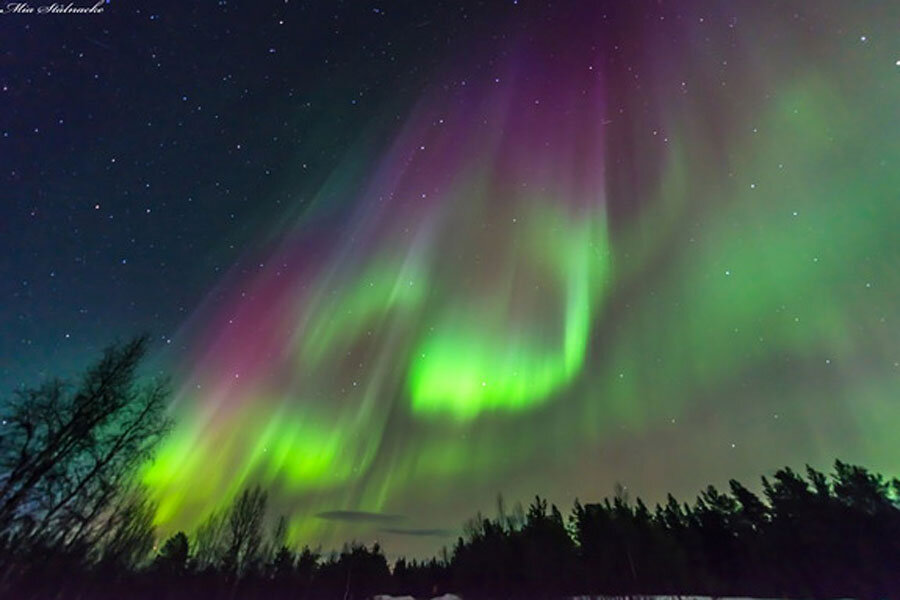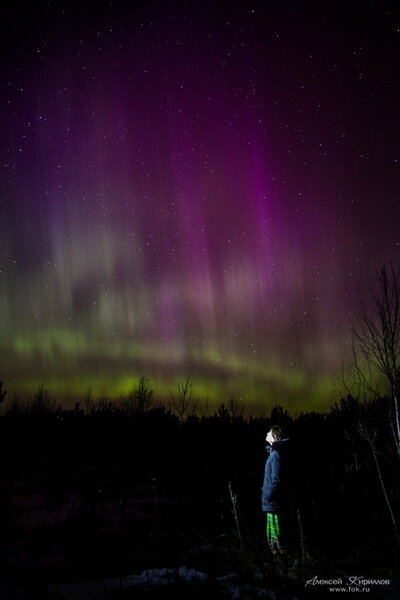Spectacular aurora photos from St. Patrick's Day solar storm
Loading...
Green auroras danced in skies around the world last night thanks to a massive solar storm that super-charged northern lights displays for St. Patrick's Day. Skywatchers captured stunning pictures of auroras in the northern United States, Canada, northern Europe and other parts of the world.
The spectacular aurora photos were captured during a powerful geomagnetic storm that lasted through the day Tuesday (March 17) and appears to have tapered off today. Scientists working with the Slooh Community Observatory were able to broadcast their views of the northern lights from Iceland while on their way to check out the total solar eclipse happening Friday (March 20).
"As the skies got slightly darker, we started seeing some of these wonderful colors, so what a day for me to see my first aurora, on a geomagnetic storm of this size. Wonderful," Slooh astronomer Paul Cox said during the Iceland aurora webcast.
Auroras occur when charged particles from the sun interact with Earth's upper atmosphere, releasing a glow that typically looks green, but can include reds and purples as well. They are typically visible over Earth's North and South poles, but can reach further down during strong geomagnetic storms like the G4-class storm observed on Tuesday.
Space.com readers in Sweden, Wisconsin, Croatia and other parts of the world sent in incredible images of the glowing auroras.
"I live in the eco-village in Kaluga region," skywatcher Alexey Kirillov told Space.com via email. "It is about 100 km [60 miles] from Moscow. Yesterday night it was possible to see great auras of northern lights here."
Kirillov sent in an amazing image of green, purple and white aurora shimmering above a tree-lined landscape.
Skywatcher Matthew Moses managed to capture a meteor streaking through the sky while he was photographing the aurora in Wisconsin.
"Just before midnight I saw a flash of a meteor as I was out photographing the northern lights," Moses told Space.com via email. "Luckily my shutter was open so I anxiously checked the back of the camera and sure enough at 11:55 CST a meteor shows as a bright streak in the Eastern edge of the green aurora band. This was seen from the shore of Lake Superior out on Wisconsin Point just outside Superior, WI."
Even astronauts on the International Space Station got a taste of the St. Patrick's Day geomagnetic storm. NASA's Terry Virts caught the green auroras on camera as he orbited Earth in the space laboratory.
"Nature's way of celebrating #StPatricksDay," Virts wrote in a post on Twitter. "The most amazing green I've seen, courtesy of a solar flare."
The brilliant auroras were particularly brilliant last night because Earth's magnetic field was being bombarded by charged particles from the G4 storm. When particles from the sun hit particles in Earth's upper atmosphere, it can excite the neutral particles, creating the amazing aurora displays seen around the world last night.
Editor's Note: If you have an amazing photo of last night's aurora or any other night sky view that you'd like to share for a possible story or image gallery, please contact managing editor Tariq Malik at spacephotos@space.com.
Follow Miriam Kramer @mirikramer. Follow us @Spacedotcom, Facebook and Google+. Original article onSpace.com.
- Incoming! Powerful X2.2 Solar Flare Blasts Towards Earth | Video
- Poll: Have You Ever Seen the Northern Lights?
- Northern Lights Photos: Amazing Aurora Views of 2014
Copyright 2015 SPACE.com, a Purch company. All rights reserved. This material may not be published, broadcast, rewritten or redistributed.









